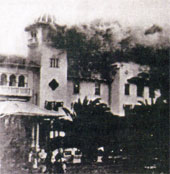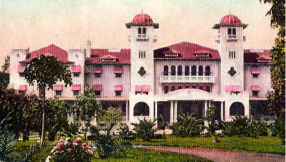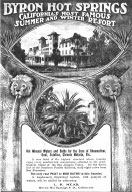

The Second Hotel
The second hotel, built soon after the, fire at a cost of $150,000.00, was situated on a small knoll directly across the square from the site of the first one. It was a three story, frame-stucco structure facing east. The broad verandas commanded a view of the San Joaquin Valley and extended across the entire front and along two sides, giving a total length of 400 feet. The offices, the doctor's office, post office, telegraph and telephone stations opened from the foyer which extended the full width of the building. Adjoining, were the billiard room, ladies reading room and other public rooms. The dining room was in the north wing and also housed the kitchen, cold storage and pantry. Guest rooms, all outside rooms, were on the second and third floors. Many were equipped with private baths with hot salt water piped in as well as normal hot and cold water.
The hotel combined many features of Spanish and Moorish architecture combined with the best features of American construction. Its architect was James W. Reid, a European trained, beaux arts architect and partner in the Reid Brothers firm of San Francisco. Among their more well known efforts include the Fairmont Hotel, San Francisco; Band Shell, Golden Gate Park, Claus Spreckles residence and building, San Francisco, Hotel del Coronado, Coronado; Portland Oregonian building, Portland, OR; and the Grand Lake Theatre, Oakland,
Byron Hot Springs Company was incorporated December 22, 1903, with Lewis Risdon Mead, Blanche D. Mead, Charles E. Parent, Sanford Bennett and Joseph W. Rolph as the Board of Directors, and the resort under the management of Mead saw its greatest period of success. With the advent of the automobile, people as far away as San Francisco, Palo Alto, Oakland and Stockton could spend week-ends bathing, playing tennis, croquet, golf, billiards, shuffle board, riding horses or relaxing in the gardens or on the verandas. Trains and buses brought people from all parts of the United States to enjoy the benefits of the waters. Success for Mead was tempered by the death of his wife, Blanche Durant Mead, at the Sp rings on December 26, 1905. The resident physician, her son Dr. Louis Durant Mead, attended her at death.
rings on December 26, 1905. The resident physician, her son Dr. Louis Durant Mead, attended her at death.
At about five o'clock Thursday morning, July 18, 1912, fire broke out in the Hotel and spread rapidly to all parts of the building, but the guests were warned in time to dress and escape and though no one suffered injury, there was great loss of personal property. R. M. Briars, the manager of the resort at the time, suspected faulty wiring as the cause.
1914 Hotel [next] [last] [back to the top]
Home l Resort Plans l History l Golf Course l Resort Store l Newsroom l Contact Us
© 2004 Byron Hot Springs

